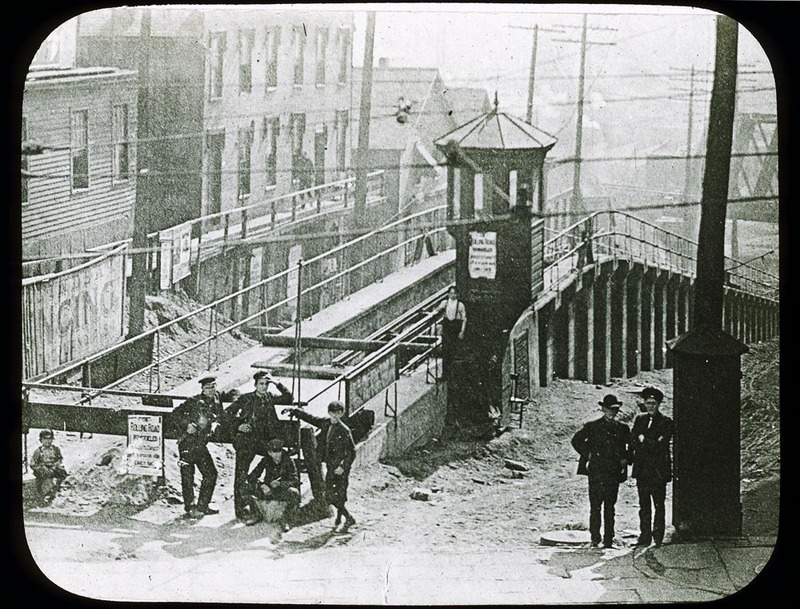Smead Rolling Road

The Smead Rolling Road was a mechanical device built into the roadbed of Eagle Avenue to help haul wagons to the top of the cliffs framing the Cuyahoga Valley in the days before sufficiently powerful trucks were developed. Vaguely reminiscent of the mechanics behind San Francisco's cable cars, this contraption lasted a brief time before being abandoned and later demolished when the tracks for the Cleveland Union Terminal were installed across Eagle Avenue's route.
Cleveland was founded in 1796 at the mouth of the Cuyahoga with Lake Erie to take advantage of the portage between the Great Lakes system and the Ohio and Mississippi rivers to New Orleans. This portage, where Akron is today, was a short land route for carrying boats that linked these water systems via the Cuyahoga River and promised a strong economic future for the young village.
In the early nineteenth century, the potential of the portage route was realized by the construction of the Ohio & Erie Canal, which accelerated Cleveland's rise as an important western commercial city. The canal entered the city alongside the river and ended near its mouth at Lake Erie, ensuring that all the heavy cargo coming to Cleveland via the canal, river and lake would arrive down at the water level, eighty feet below the city. Railroads, which tended to employ the long grades of the Cuyahoga's tributary streams to enter the valley and its docks, further concentrated the arrival of heavy freight below where the population lived, worked, and shopped.
Before trucks came to have sufficient power to traverse the steep grades of the river banks, it was difficult for horse-powered wagons to supply produce to the city. To address this problem, in 1906 inventor Isaac D. Smead patented his "rolling road," a electric-powered device to pull unharnessed wagons up Eagle Avenue from the Flats to Ontario Street, right at the popular Central Market.
In the nineteenth century, "Colonel" Smead had been a major figure in the heating and ventilating business, at one point reputed to be the leading manufacturer of such equipment for public buildings in America. The Panic of 1893 led to his bankruptcy and he turned to other engineering pursuits. He designed the rolling road as an electric-powered moving belt, to which wagons could be attached. The wagon's team of horses would be unharnessed and walked uphill while the wagon made the trip up the rolling road at three to six miles per hour. The former process of moving wagons up by horsepower alone was said to take twenty minutes to an hour, while Smead's invention cut it to two minutes.
While it appears to have operated satisfactorily, it wasn't long before improvements in internal combustion engines powered trucks sufficiently to render it obsolete, when it was abandoned and its remnants dominating the center of Eagle Avenue for years. Writing in his memoirs, The Ginney Block, Edward D'Alessandro told a tragic story about his youth and the remains of the rolling road. A gang of his friends and he were racing on sleds down Eagle Avenue. The youth in the lead slid out into the intersection with Canal Road and was killed by a passing truck. D'Alessandro, who would later go on to lead the Cleveland Public Library system, was able to swerve his sled into the rolling road's foundations and escape a similar fate.
In the 1920s the Terminal Tower complex on Public Square was being built and its Cleveland Union Terminal passenger station in the lower sections was designed to bring trains through the valley. This wiped out Eagle Avenue, which henceforth traversed a bridge over the tracks. That bridge lasted into the 21st century, when much of it in turn was demolished and thus Eagle Avenue no longer connects Ontario Street with the Flats. But for decades, between the Smead Rolling Road and the subsequent bridge, Eagle Avenue was one of the city's more engineered roads.
Images





